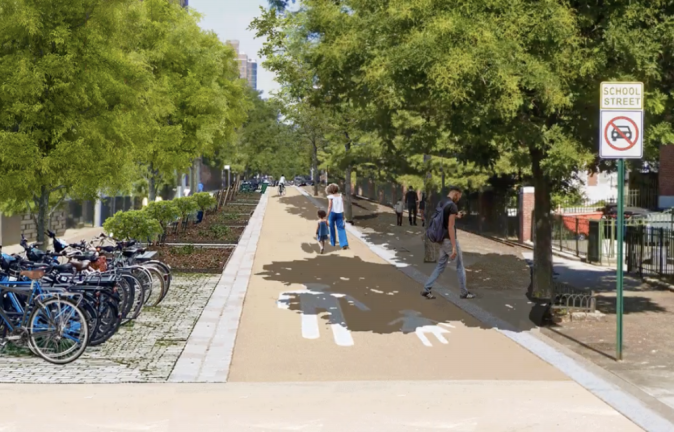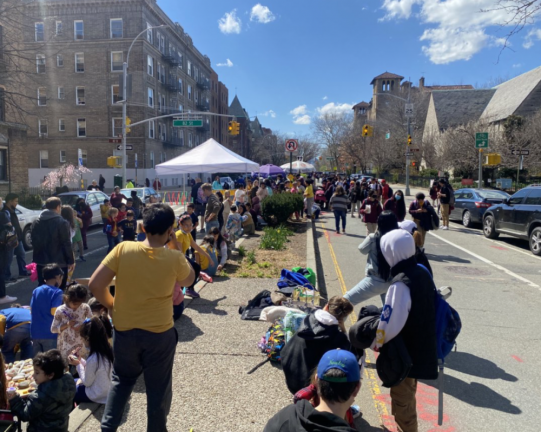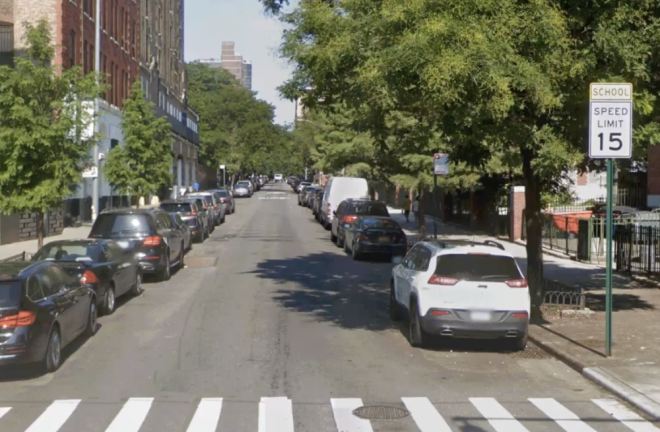Pedestrian-Friendly Streets for Kids
Streetopia pushes for more “School Streets” on Upper West Side



What do Venice, Italy, Pontevedra, Spain and Stroget, Copenhagen have in common? They have all freed their city centers from cars, says Streetopia Upper West Side, a new advocacy organization with the goal of reimagining the way we use our Upper West Side Streets.
While the organization currently has campaigns surrounding protected bike lanes and smarter intersections, a new area of focus for the group is advocating for what they call “School Streets”: streets surrounding city schools that are closed to all vehicle traffic during school hours, and instead open to kids.
In the height of the pandemic, the Department of Transportation launched their Open Streets Full Closure Schools Program which evolved from the Play Streets program and “Outdoor Learning.” As part of the program, schools that applied to become “Full Closure” could close their streets to car traffic, either during school hours or during drop-off and pick-up hours.
“During the pandemic, the city started to realize, and the general population started to realize the value of public space and how much space is given over to cars,” architect and Streetopia UWS advocate Carl Mahaney said. “People recognize that some of the school buildings are a little bit limited in space, or the yards where the kids play are not as big as they need to be, so taking a little more space for schools just became kind of logical.”
Not only do School Streets meet the need of space for kids, but even more importantly, they make the front of those schools safer and it makes getting to school safer, quieter and cleaner, Mahaney said.
“We’ve seen this all over the city, not so much on the Upper West Side, but we’ve seen it in other parts of the city how much nicer pickup and drop-off are when parents and staff have that space in front of the school,” he said.
According to a spokesperson from the Department of Transportation, schools can apply for an open street via the DOT website and must commit to the operation of the street. The street is typically operated by school staff and volunteers.
Only One on the UWS
But a map of all the Open Street Full Closure Schools on the DOT website shows that while there are many “Schools Streets” in Brooklyn and Lower Manhattan, and even several on the Upper East Side, there are hardly any on the Upper West Side, Mahaney noted. Of the 42 approved “School Streets” on the DOT website, only one of those is on the Upper West Side (the Parkside School on 72nd between Central Park West and Columbus).
“That’s what we’re trying to get to the bottom of, and I don’t have the answer yet,” Mahaney replied when asked about why the Upper West Side has fewer School Streets than other neighborhoods.
Mahaney said that Streetopia UWS has been conducting research to try to understand why school’s do and don’t apply to obtain a “School Street,” the different street arrangements that schools have and how they operate their School Streets.
“We’re just starting to talk to people at different schools to understand how they arrived at the arrangement they have, or in one case, how they lost one of the streets that they had,” Mahaney said, referencing a school in the West Village which Mahaney said had two operating School Streets, but ended up losing one of them.
“Our goal with the campaign is to understand all of the possibilities and maybe missed opportunities with the [existing] program so that we can suggest improvements,” Mahaney added. “We’re doing that by talking to schools, school staff, administrators and parents who have both successfully lobbied to get a School Street or applied to get a School Street and been unsuccessful.”
City Council Member Gale Brewer said while she supports more open streets in general, like the Columbus Avenue Open Street on Sundays (from 68th to 77th street), whether or not a school obtains a School Street designation should be up to the schools themselves.
“You have to know that the school wants it,” Brewer said.
Streetopia UWS contends that it is the job of the city to build the program, as all of the responsibilities of running the street currently fall on school staffers and volunteers.
“The burden should be on the city to stand this program up, not individual schools,” the organization tweeted on Tuesday.
Crash Data
Mahaney pointed out a recent study conducted by Streetsblog who studied crash data in New York City from July 2015 to November 2021, and found that “on school days, streets near schools are more dangerous on average than other city streets.”
The study found that from eight to nine in the morning on school days, there are 57% more crashes on streets near schools than on other city streets.
“One of the goals of [the campaign] too is to address that safety ... it shouldn’t be dangerous to get to school,” Mahaney said.
The School Streets campaign is only a small part of Streetopia’s larger mission of shifting the New York City landscape from one that is car-dominated to one that is pedestrian-friendly.
“Our vision is Upper West Side streets that are lively, green, and healthy places where neighbors meet, kids play, and people move efficiently and safely on foot, by bike and in transit,” their website reads.